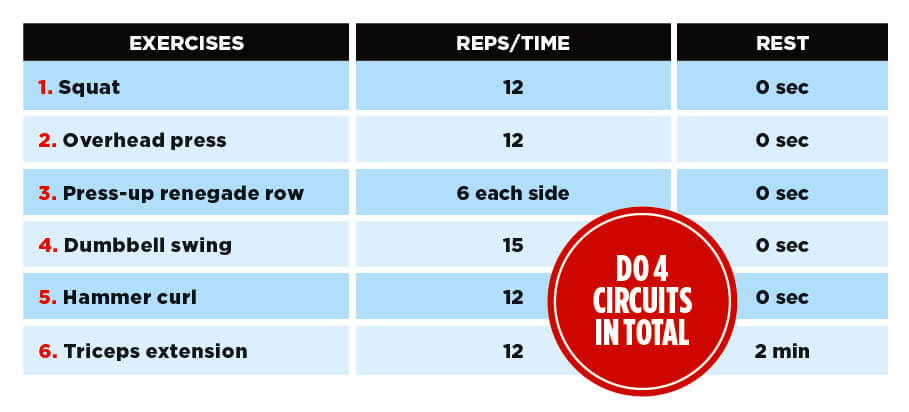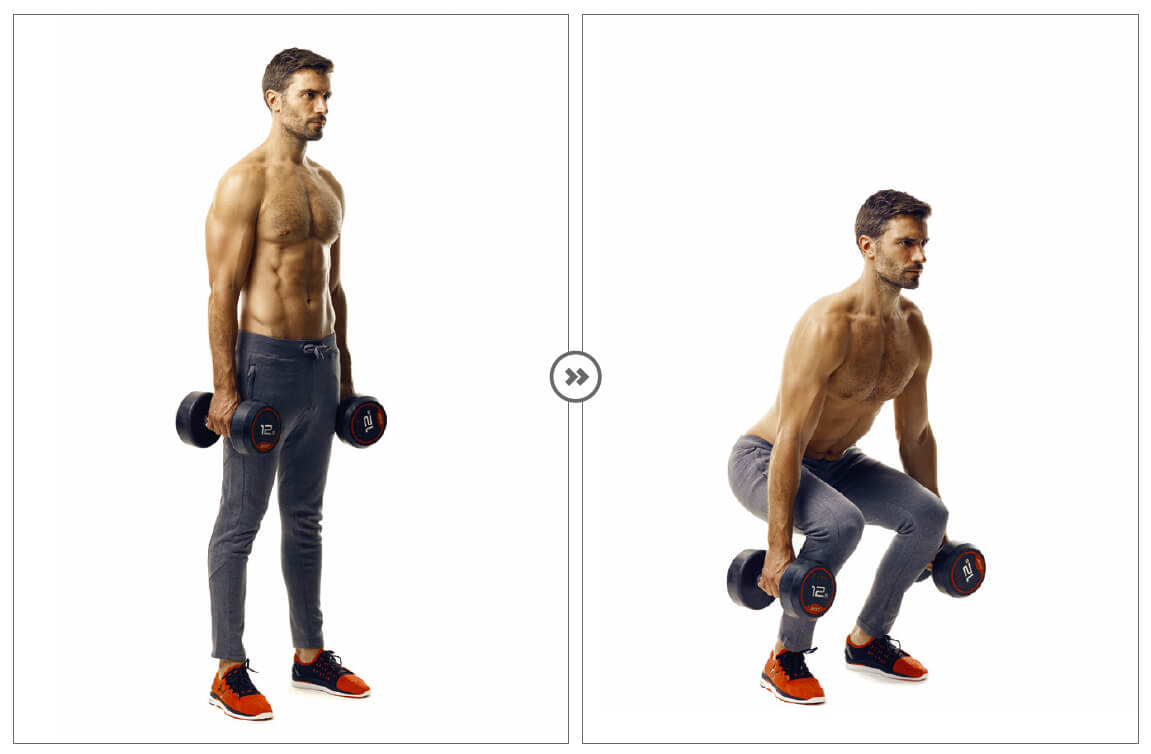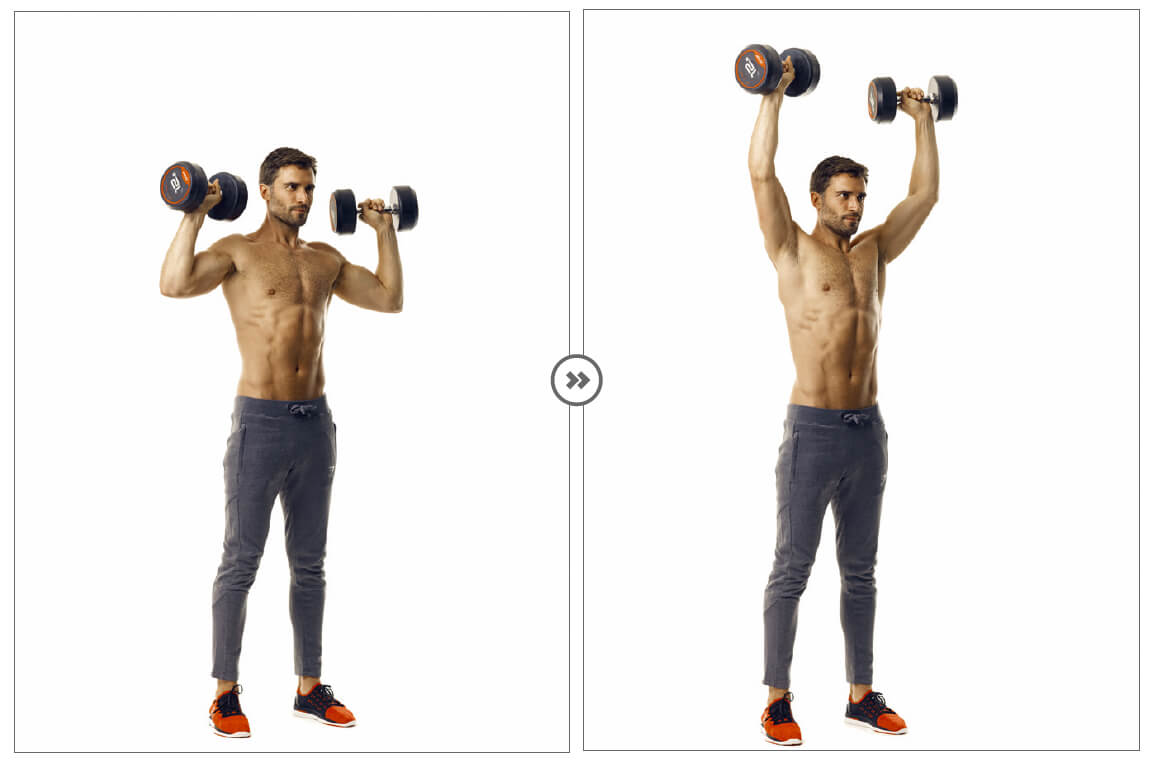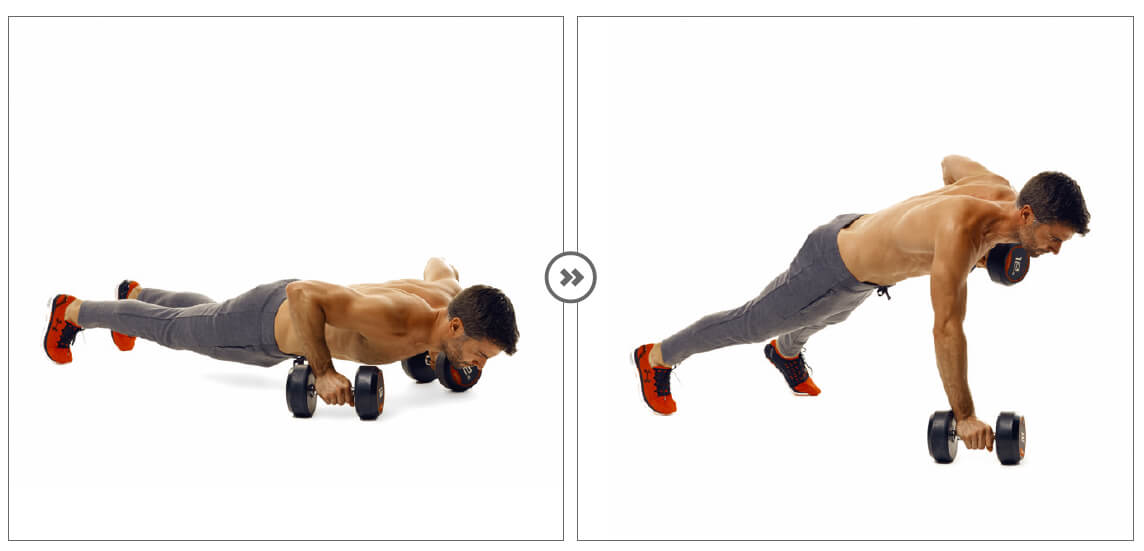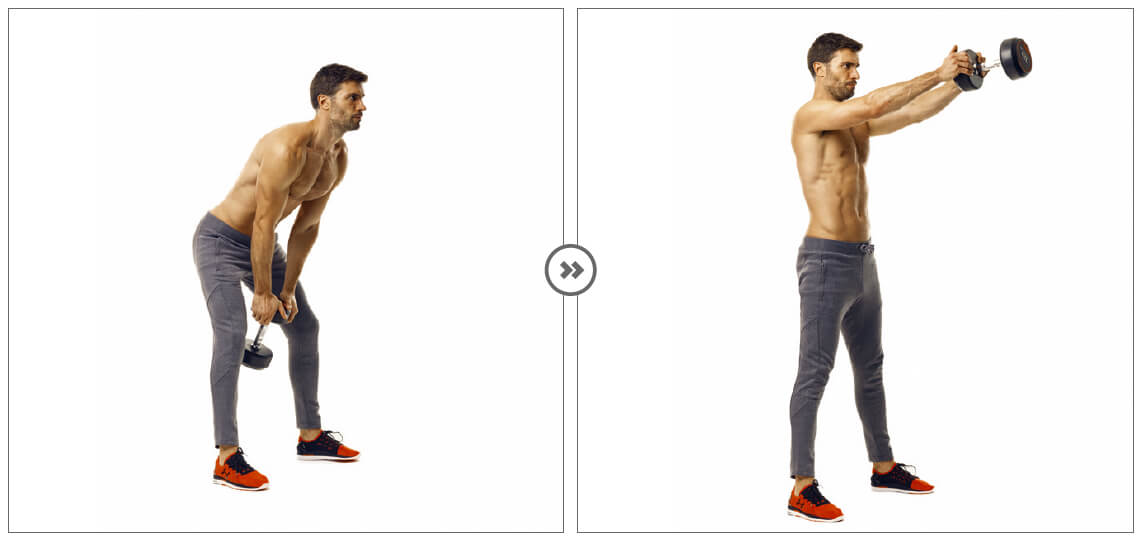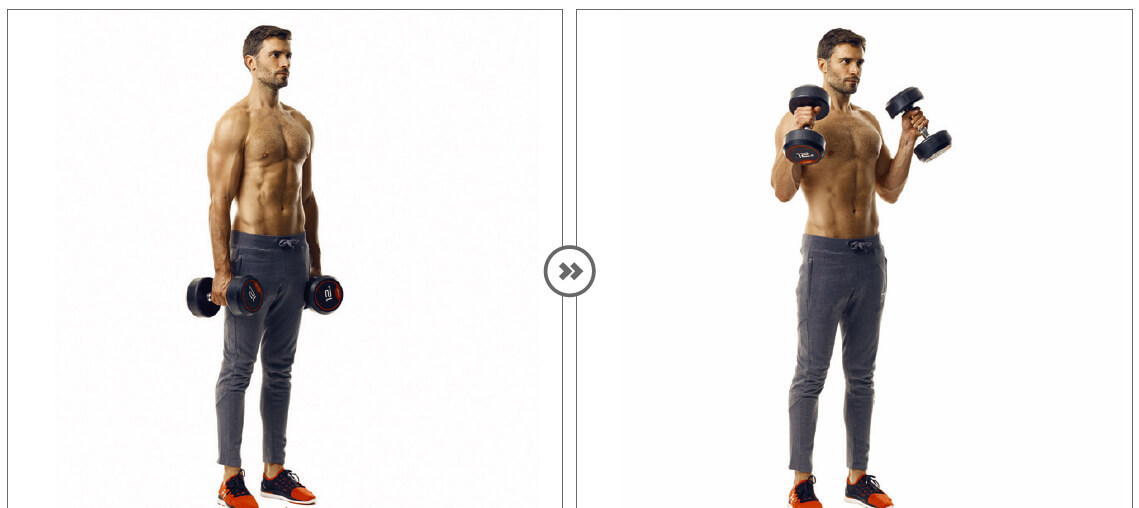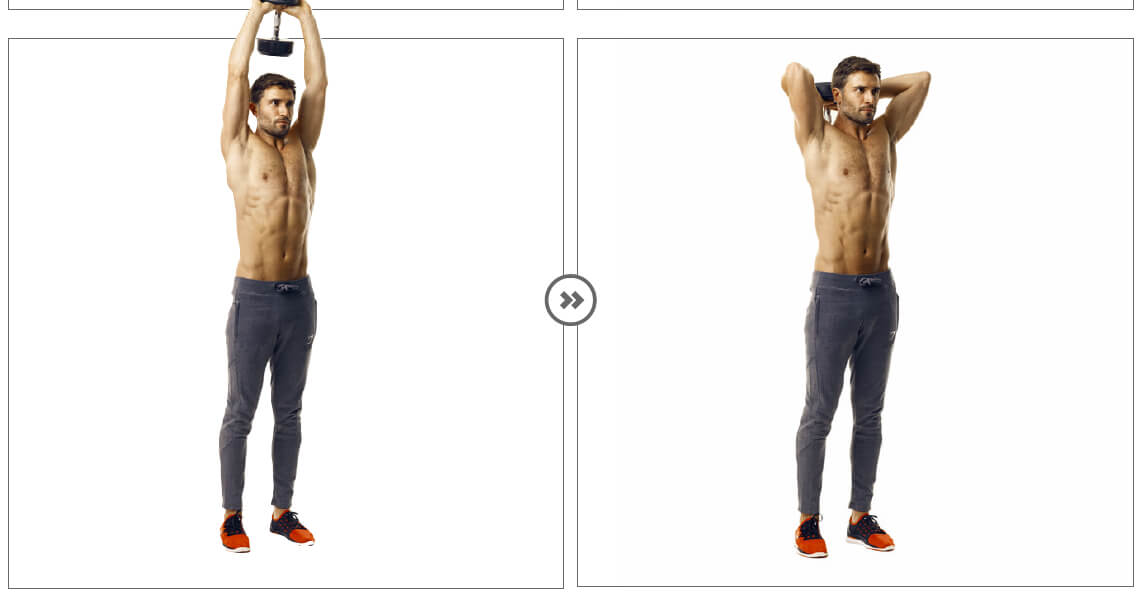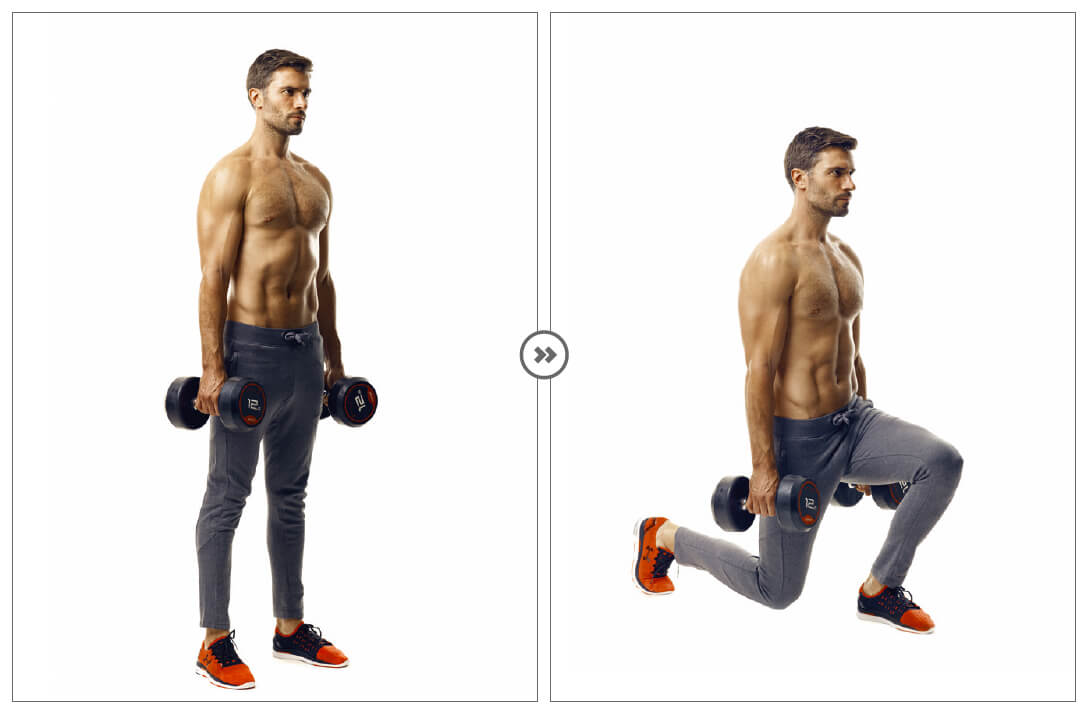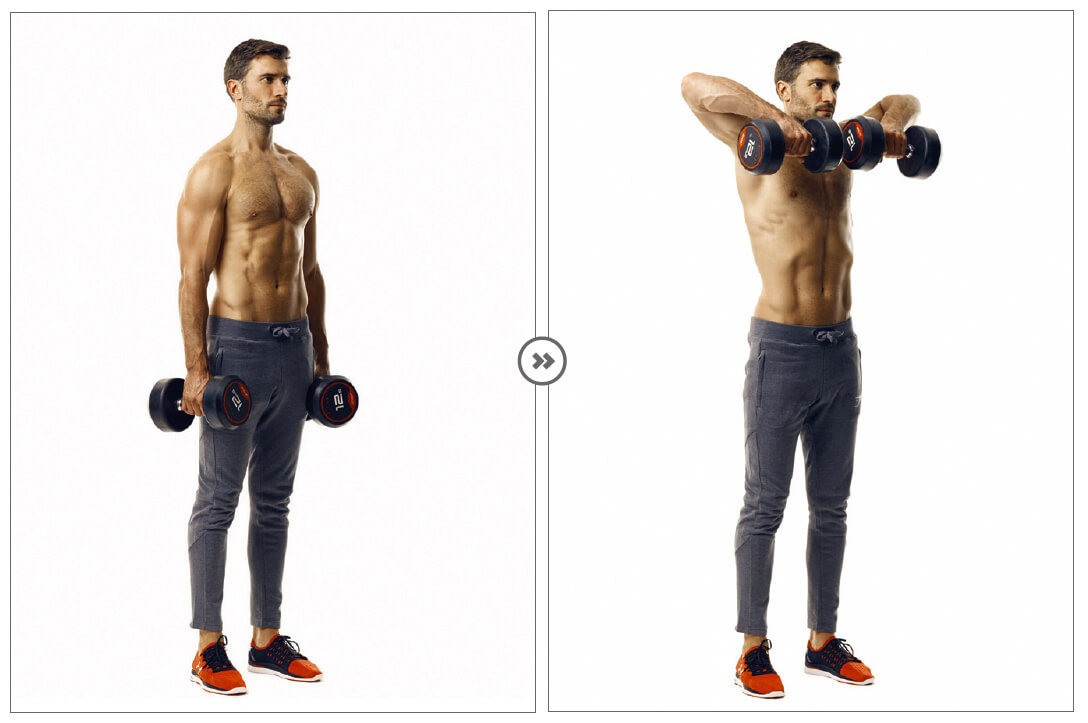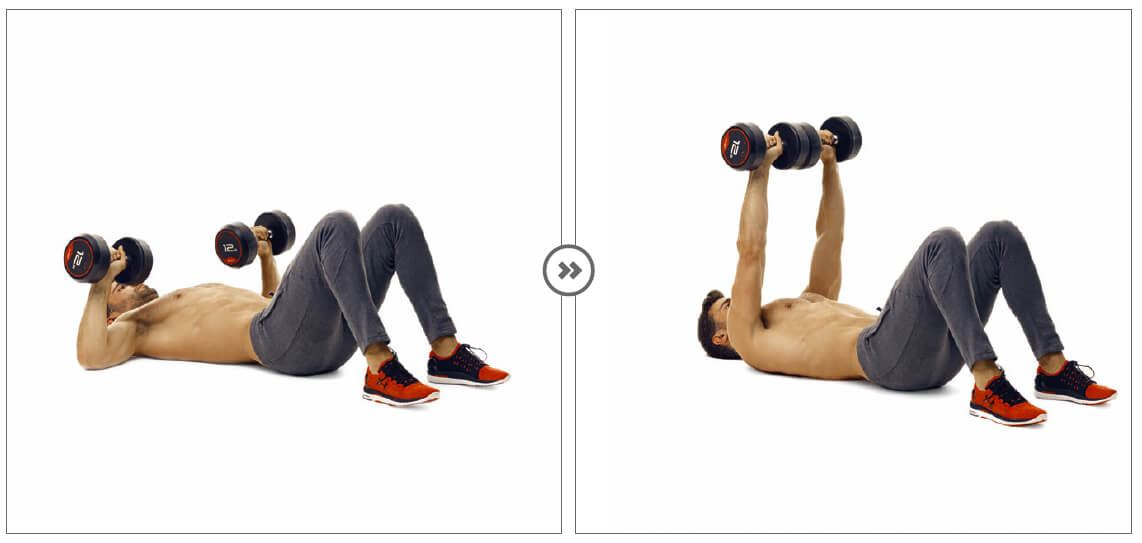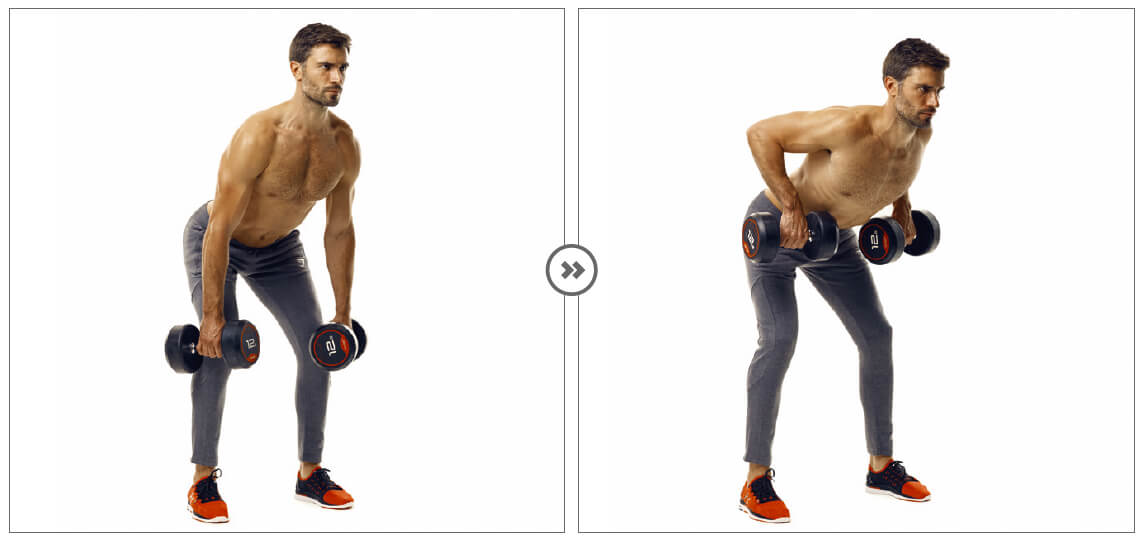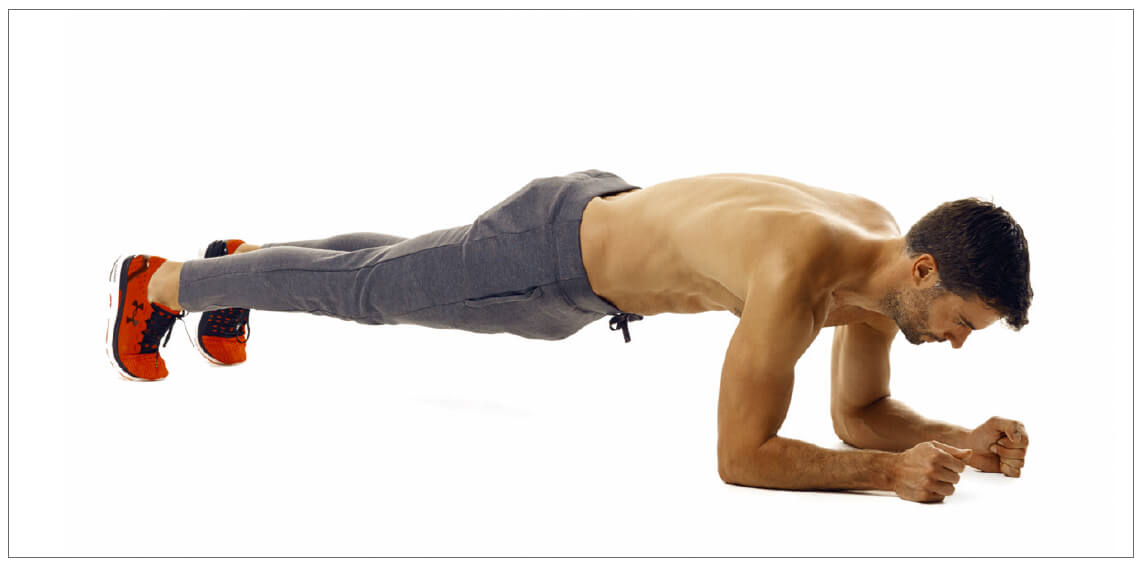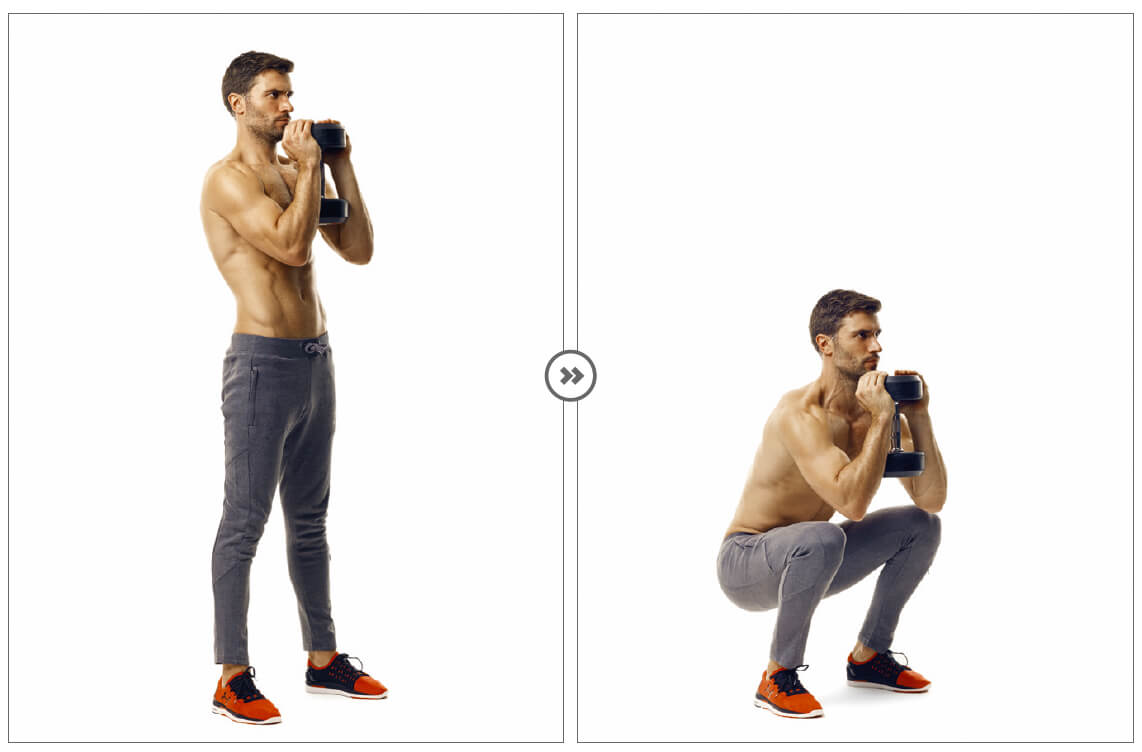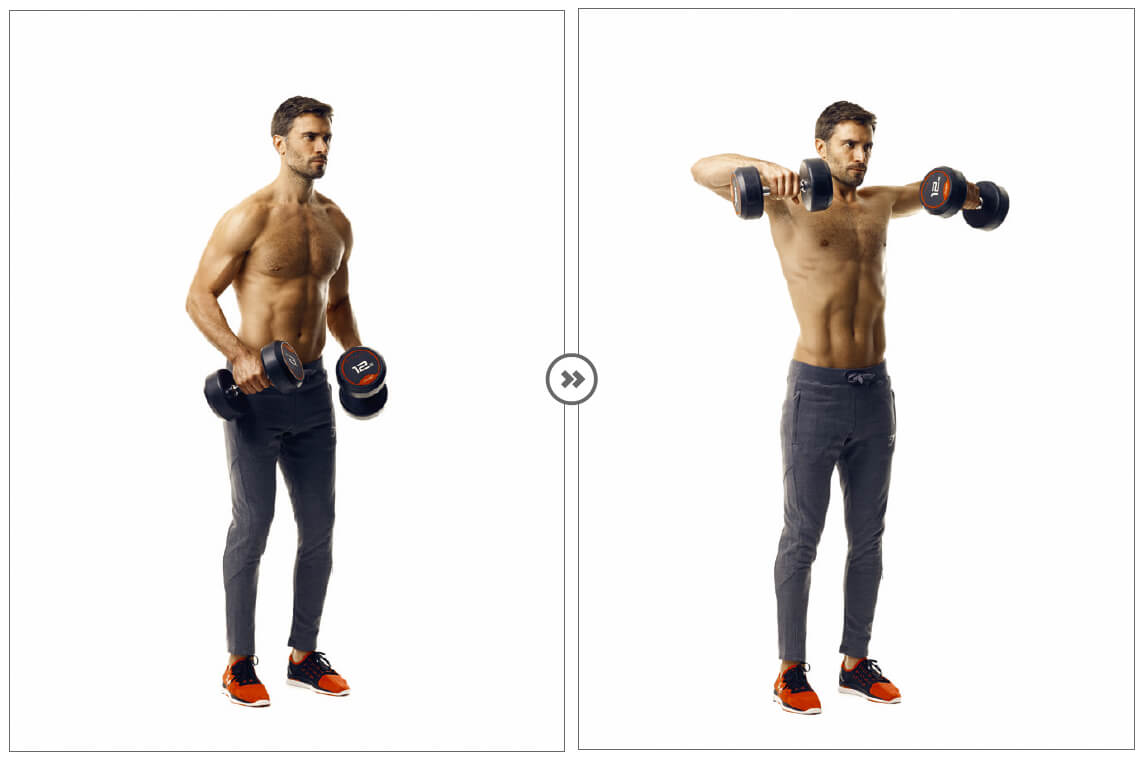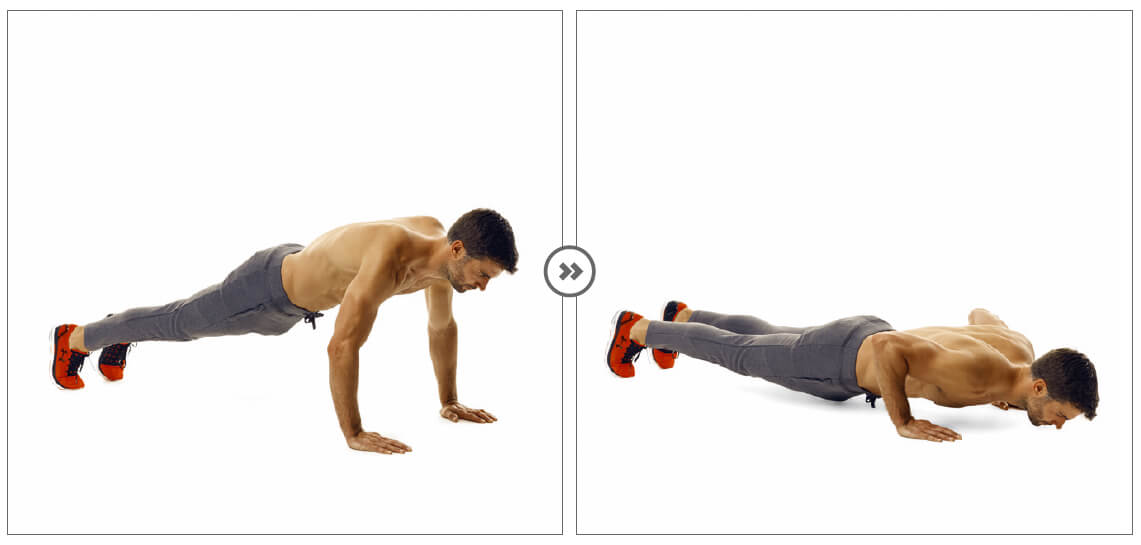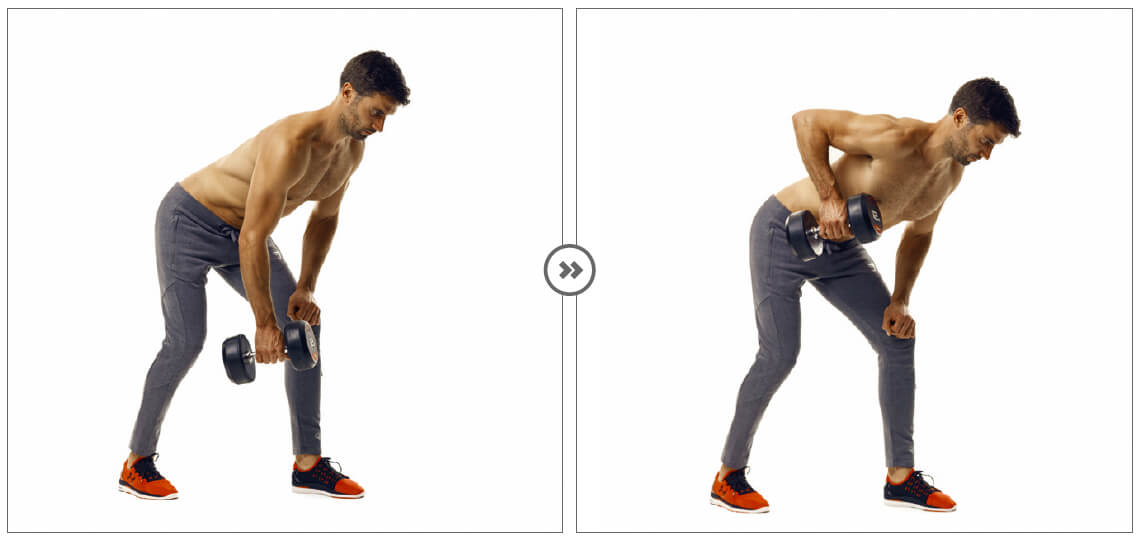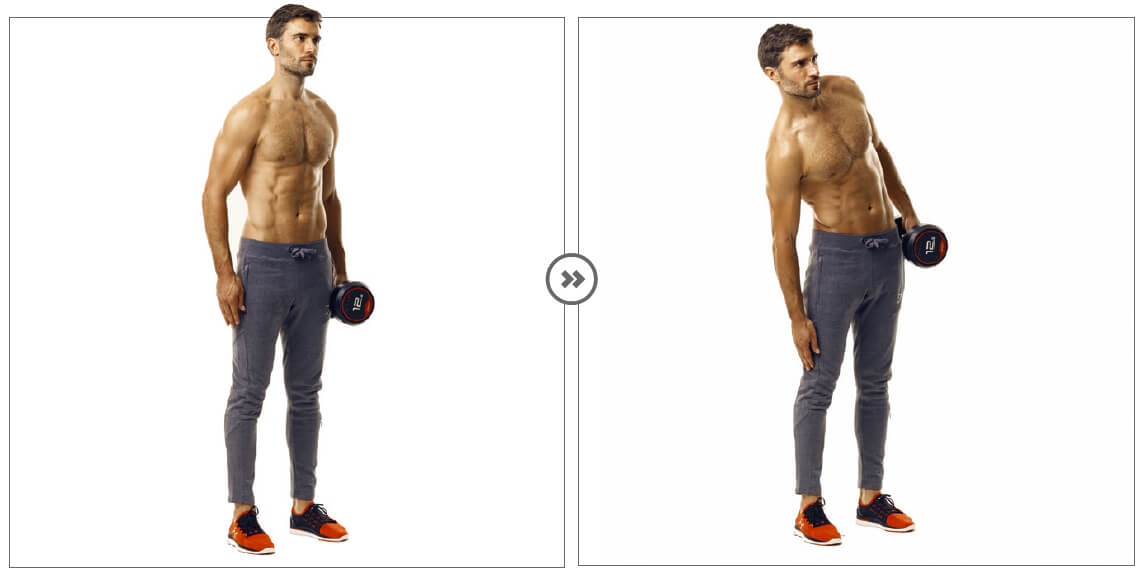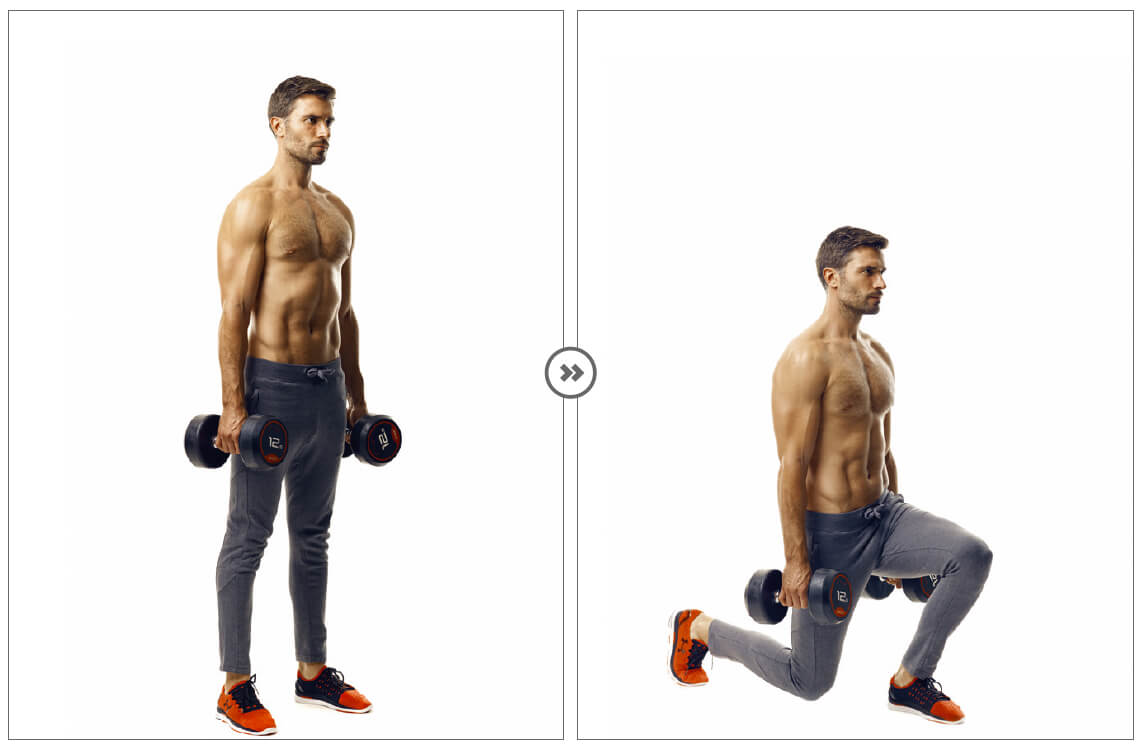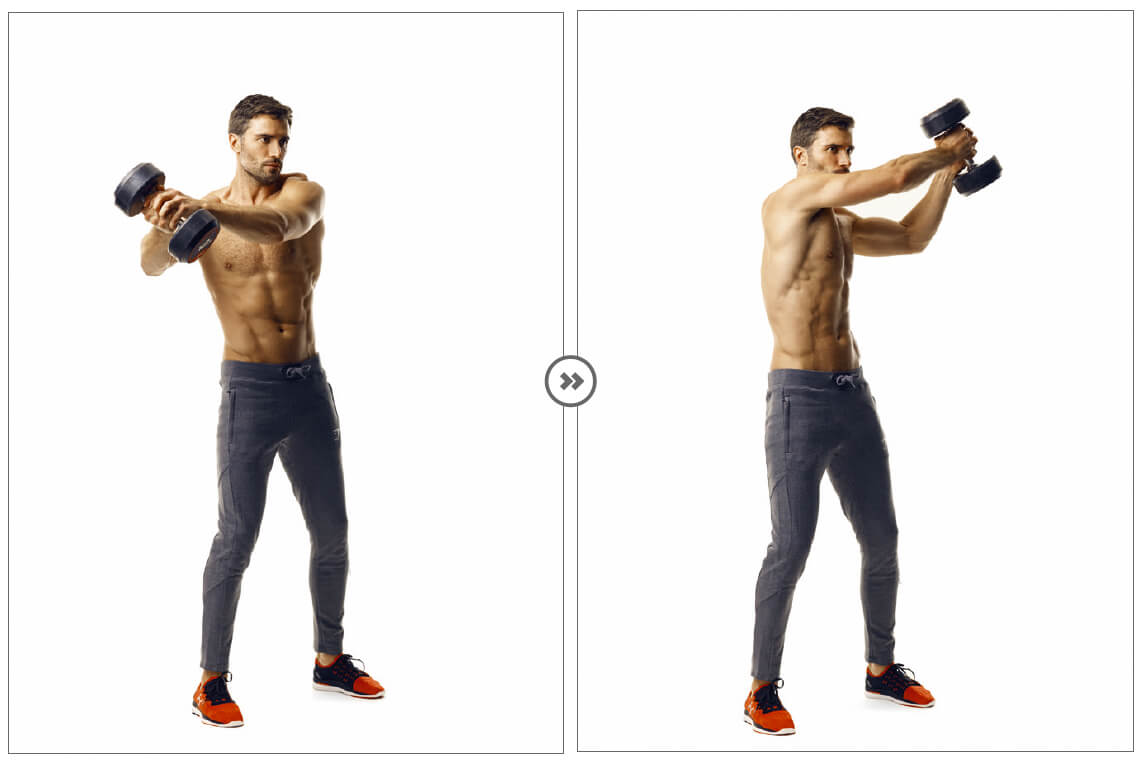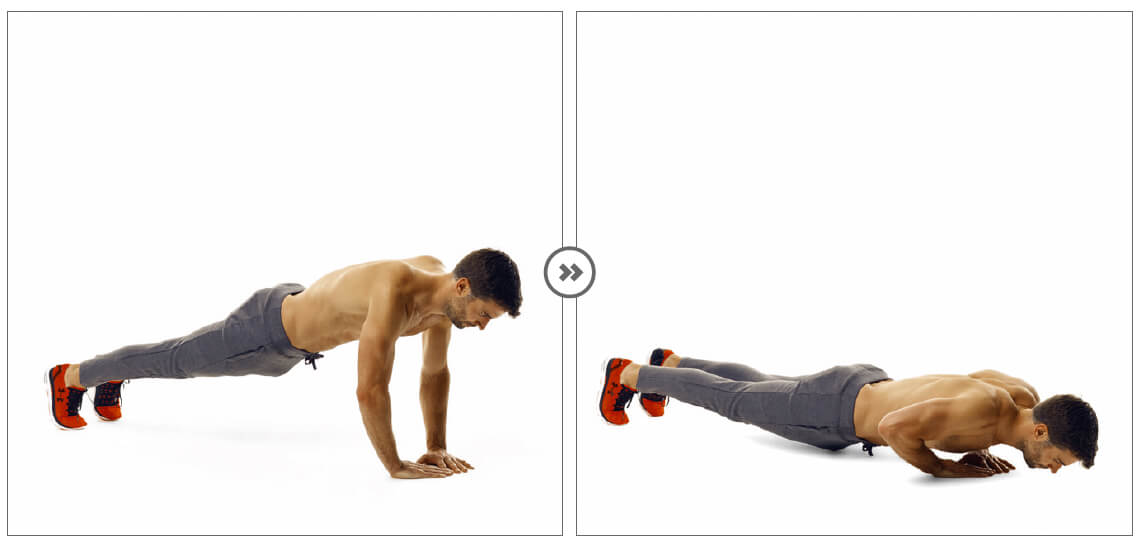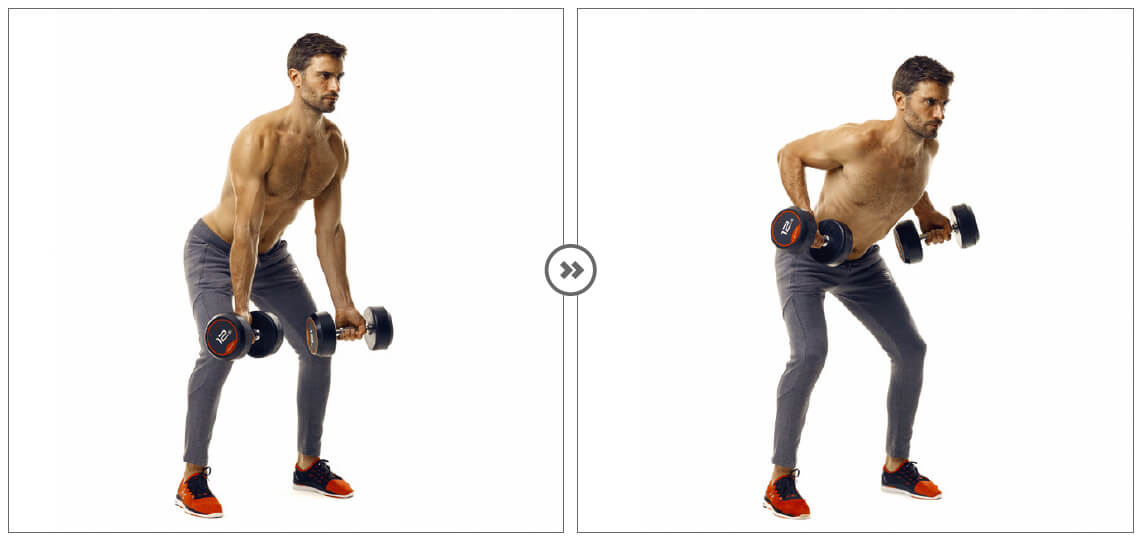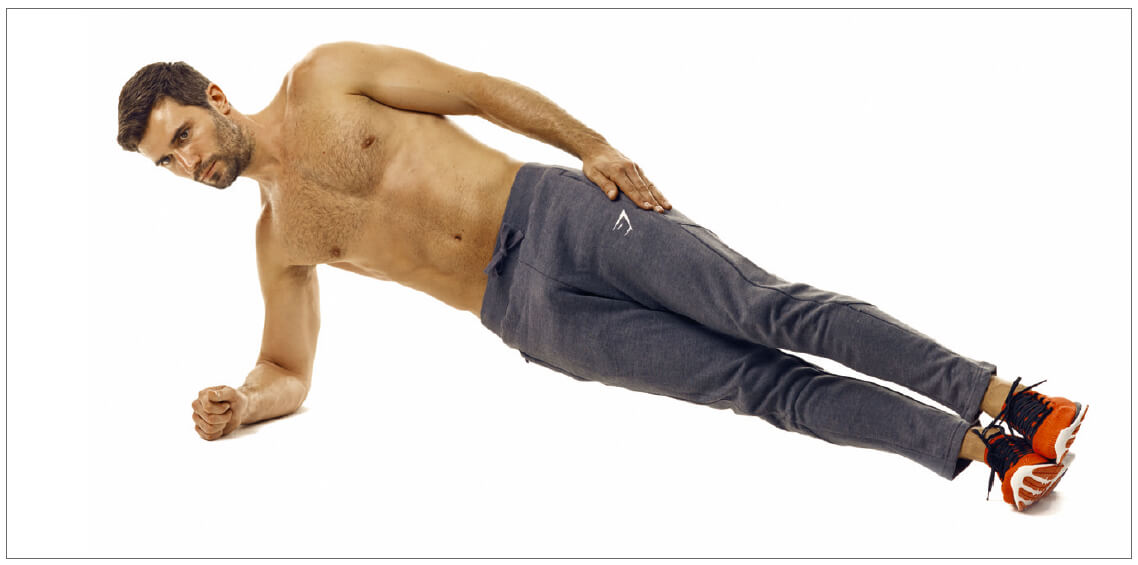This 6-week fat loss plan uses high-intensity resistance training to deliver impressive results…
High-intensity interval training offers a highly effective (and highly sweaty) fast track to lose belly fat. Read on for everything you need to know about building fat-loss workouts. Then follow our detailed step-by-step plan that will transform your body in six weeks.
Get kitted out for this workout plan with our pick of the best dumbbell sets
Try the Jordan Fitness Premium Urethane Dumbbells
BUY IT NOW:
$52-$1,553 / £42-£1,260 / jordanfitness.com
High-intensity interval training, or HIIT, has become popular in recent years, Unlike some fitness fads – there’s a lot of evidence to support its effectiveness as a training system. One of the benefits that you don’t need a degree in exercise science to understand is that HIIT workouts tend to be short. Most of the sessions over the folowing pages come in at around 20 minutes.
For most people, a short HIIT workout more attractive than spending an hour in the gym or pounding the pavements endlessly. In fact, in a 2014 study researchers found that when they asked subjects to list their barriers to exercise, “lack of time” was the most common response. Similarly, if motivation is a problem, HIIT could be the answer. The intense, dynamic and challenging nature of the workouts mean that they are always engaging – you’ll get tired, for sure, but you won’t be bored.
Some solid scientific data backs up the idea of using HIIT for fat loss. One study, published in the Journal of Sports Medicine and Physical Fitness, compared conventional gym training with HIIT training and found that “HIIT resulted in significantly greater reduction in both abdominal girth and visceral adiposity compared with conventional training”. The same study also found that HIIT had a positive impact on total body fat, hand grip strength, sprint endurance, jumping ability and flexibility.
There are other benefits you get from doing a HIIT workout that involves resistance training as opposed to just cardiovascular activity, such as running or cycling. Pure cardio activity is useful, but it shouldn’t be the only kind of training you do. Lifting weights will improve your strength and your body composition (improving your ratio of muscle to body fat). Do that and you’ll usher in a host of other health benefits, such as increased life expectancy and reduced risk of heart disease.
Of course, just as one type of training won’t give you everything you’re looking for. HIIT shouldn’t be used in isolation. However, combine it with other forms of training, including some longer, steadier sessions that build your aerobic base, and you’ll begin to make some significant changes to your body in a relatively short space of time.
RELATED CONTENT:
- Best low-calorie beers
- Best adjustable dumbbells for multi-weight workouts
- 7-inch inseam shorts for every type of workout
How to burn body fat
Fat loss might start in the kitchen, but it accelerates in the gym. By working at high intensity and building some muscle, you’ll torch fat as well as ramping up your metabolism, making the fat burning process faster and easier. The following six-week plan gives you workouts to follow but with the advice below, you’ll be able to create your own sessions, too. That means you can continue to make progress or adjust your training according to your needs.
Discover the best meal delivery services
If I do fat loss workouts, can I eat what I want?
No. Sorry! Training might give you a bit of leeway with an otherwise-strict diet, but even a savage hour in the gym is easily undone with a whipped-cream mochaccino. Stay on top of what you eat, although you shouldn’t beat yourself up over the occasional slip-up.
Check out our Nutrition Archive for high-protein recipes, reviews of the latest nutrition products, cooking tips and more
How often can I do a fat loss workout?
If you’re going to do high-intensity sessions, three or four times a week is a sensible upper limit – you’d be better off spending any extra time on muscle-building moves, or even just shopping for food and cooking. Want more work? Go for a nice long walk: it’ll burn calories without over-stressing your system.
Discover the best bodyweight exercises
Do I need to do any other type of training?
If you’re doing strength movements as part of your fat loss, you’re probably fine. Strength will alleviate your risk of age-related disease, and a bit of muscle will mean you look better once you’ve stripped away the fat.
How long do fat loss workouts need to be?
Here’s the good news: fat-loss workouts are some of the shortest you can do while still making great progress. Even 15 minutes is enough – do a quick warm-up, then hit a training interval (eg 30 seconds of work and 30 seconds of rest) for ten minutes, and you’re done.
How this fat loss plan works
How much of a difference it is possible to make to how you look and feel in six weeks? The good news: you can make a big change. The less good, more realistic news is that you can only make that change if you follow an effective plan and work hard. We’ve done the first bit for you, but the second element is entirely dependent on your commitment. So before you start your six-week fat-loss transformation, remind yourself why you’re doing this.
A compelling ‘why’ will improve your mindset and make sure you know how to start this particular fitness journey and stick with it. You also need to make sure you eat well in conjunction with the workout plan if you want to get the most impressive results possible – plenty of protein, such as lean meat, eggs, pulses and tofu.
Try this 15-minute workout to burn fat, fast
How does the plan work?
It’s simple: you complete four circuit workouts a week for six weeks. Each circuit is a whole-body workout and you do the same circuits each week, but change the rep and rest variables to make them progressively harder. The only kit you need to complete the workouts is a set of dumbbells, so you can do it either in the gym or at home. It’s advisable to take rest days between workout days – but, unlike heavy weights workouts, they’re not so taxing that it’s essential.
Why does the plan work?
There are several key reasons why the plan works. Each circuit is a whole-body workout, so every major muscle group in your body is challenged. This will help you to develop more muscle mass and, because muscle is active tissue, it will also have a positive impact on the calories you burn at rest. The workouts also get your heart rate high, so you’ll burn a lot of calories both during and after your session. The plan also gets progressively harder so your gains won’t plateau.
What if I’m a beginner?
This is a beginner-friendly plan, because you don’t need lots of fancy kit and all the exercises involved are achievable if you’re in good health. The weight you select is up to you, so if you’re a beginner, start light and gradually increase the load. You should aim to reach failure – the point at which you can’t continue with good form – at the end of each circuit. If you’re failing before then, reduce the weight. If you’re struggling, you can do some moves, such as squats, without weights.
What do I do after six weeks?
The first thing you should do is give yourself a big pat on your, by now, lean and muscular back. Completing any training plan takes a considerable amount of work and dedication, so focus first on getting to the end of the programme. Once you’ve done that, you can decide on what would be your best next move. Your main options: doing it over again but this time with a heavier weight; deciding on a muscle-building plan; or taking on an entirely new fitness challenge, to mix things up.
The 6-week fat loss plan
WEEK 1
Circuit 1
We could have been nice and eased you in gently but, instead, we’ve chucked you in at the deep end.
This circuit starts with the squats – the classic lower-body move – followed by the overhead press and then the renegade row, which is one of the most challenging and effective exercises in this plan. The important thing to remember, however, is that it’s the quality of your reps that count, so take your time and stick to the form guides.
The fourth exercise is where we see the tempo increase. The swing is an explosive move, so speed and intensity are important to get the most out of this pulse-raising exercise. The two arms exercises at the end of the circuit are less demanding on your heart and lungs, but ensure that you get a full-body workout.
1. Dumbbell squat
The dumbbell version of this classic legs move will also develop your grip, because you have to hold the dumbbells securely for the duration of the set. Keeping your shoulders back throughout the set will recruit your back muscles, too.
- Stand tall with your chest up and your core braced, holding a dumbbell in each hand.
- Bend your knees to squat down until your thighs are at least parallel to the ground, then press down through your heels to return to the start.
2. Dumbbell overhead press
Your aim here should be to go as heavy as possible, because the rep count is comparatively low. As well as developing shoulder strength and size, this move also works your core because you have to stabilise your torso.
- Stand tall with your chest up and your core braced, holding a dumbbell in each hand at shoulder height with palms facing forwards.
- Press the weights directly overhead, so your arms are straight, then return slowly to the start.
3. Press-up renegade row
This is a demanding exercise, so you do it while you’re fresh. You work your chest muscles during the press-up and your back muscles during the row, giving you a lot of bang for your muscle-building buck.
- Start in a press-up position, holding a dumbbell in each hand. Perform a press-up then, keeping your core braced, row your right hand up, leading with your elbow.
- Lower it back to the floor. Alternate sides with each rep.
For more dumbbell moves, check out our guide to the best dumbbell exercises for every body part
4. Dumbbell swing
This should be done as an explosive, high-energy exercise. Doing so will help you to develop a powerful hip drive (the key to this move) and also get your heart rate soaring towards the end of the circuit for a greater fat burn.
- Stand holding a dumbbell between your legs.
- Bend forwards, hingeing at the hips, to send the dumbbell between your legs, then push your hips forwards to straighten up and swing the dumbbell up to shoulder height.
5. Dumbbell hammer curl
The hammer-grip version of the classic curl provides a real challenge to your biceps muscles, ensuring that you stimulate as many muscle fibres as possible so they repair themselves and grow.
- Stand tall with your chest up and your core braced, holding a dumbbell in each hand with palms facing each other.
- Keeping your elbows tight to your sides, curl the weights up to shoulder height.
- Slowly lower the weights to the start.
6. Dumbbell triceps extension
This is one of the few moves that effectively isolates the triceps muscles, giving you balanced gains in your upper arms after the previous exercise and more all-over muscle mass to help you burn fat.
- Stand tall with your chest up and your core braced, holding a dumbbell in both hands behind your head with your elbows pointing up.
- Straighten your arms to lift the weights, then lower them to return to the start.
Circuit 2
Recover properly between these circuits with this guide to muscle recovery
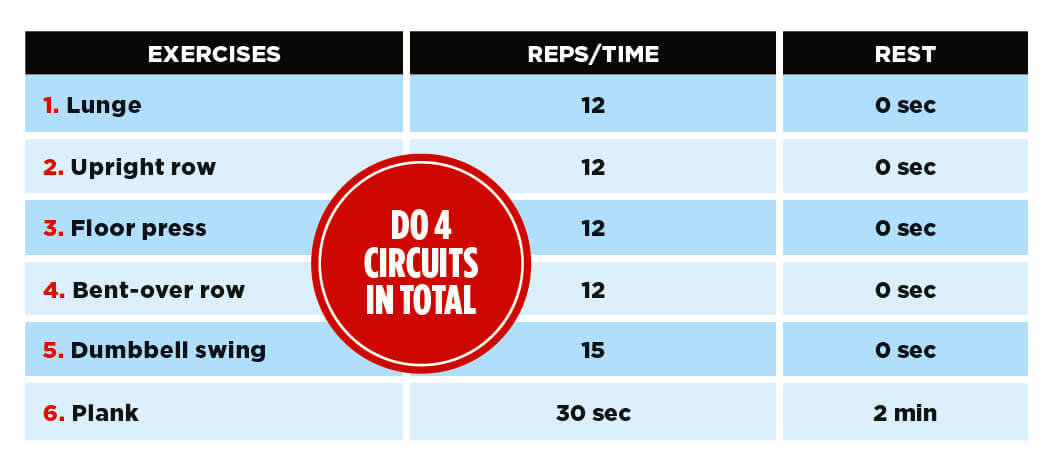
The main aim in this workout, just as it was in circuit 1, is to give you a whole-body workout that also gets your pulse racing.
The lunge is an excellent lower-body exercise that tests both balance and coordination. The three following exercises focus on different muscle groups within the upper body. The penultimate move is the dumbbell swing, which makes a reappearance because it is so useful for taxing your cardiovascular system, while also developing your posterior chain (the muscles that run along the back of your body).
By the end of the swings, your heart rate will be near its maximum, hence the strategic inclusion of the plank at the end – a core-builder that gradually brings your heart rate down before the rest period between circuits.
1. Dumbbell lunge
Working one leg at a time will mean that you get balanced muscle development. This exercise is also a test of grip strength as well as balance, because you hold on to the weights for the entire set.
- Stand tall with your chest up and your core braced, holding a dumbbell in each hand.
- Take a step forwards until both knees are at 90°.
- Push back off your front foot to return to the start.
- Repeat, leading with your other leg.
- Alternate sides.
2. Dumbbell upright row
This move will help to add muscle size to your traps (the muscles at the top of your back), while also giving your shoulders width, which will complement your newly lean waist to show off a coveted V-shaped torso.
- Stand tall, holding a dumbbell in each hand.
- Raise the weights to your shoulders, leading with your elbows.
- Slowly lower the weights back to the start position.
3. Dumbbell floor press
Lying on the floor puts you in a stable position, so you can attempt to go quite heavy with this move. The range of motion is shorter than a bench press, so focus on contracting the target chest muscles.
- Lie flat on the floor, holding a dumbbell in each hand above your chest with straight arms.
- Lower the weights towards your chest, then press them back up powerfully to return to the start position.
4. Dumbbell bent-over row
Using dumbbells for this back move will ensure that you get equal muscle development on both sides and gives you a big range of motion, so you can concentrate on squeezing your shoulder blades together at the top of the move.
- Stand tall with your chest up and your core braced, holding a dumbbell in each hand.
- Bend forwards – hingeing at the hips, not the waist – then row the weights up to your sides, leading with your elbows.
- Lower back to the start.
5. Dumbbell swing
This should be done as an explosive, high-energy exercise. That will help you to develop a powerful hip drive (the key to this move) and also get your heart rate soaring towards the end of the circuit, for a greater fat burn.
- Stand holding a dumbbell between your legs.
- Bend forwards, hingeing at the hips, to send the dumbbell between your legs, then push your hips forwards to straighten up and swing the dumbbell up to shoulder height.
6. Plank
Your chest and back muscles will now be fatigued, so this final move is a chance to work on your abdominals and your core stability. As well as helping your abs look good, it will give you a solid base to perform the moves in this plan.
- Make sure your body is in a straight line from head to heels.
- Your elbows should be directly below your shoulders and your weight should be distributed evenly across your feet and forearms.
- Hold the position.
Circuit 3
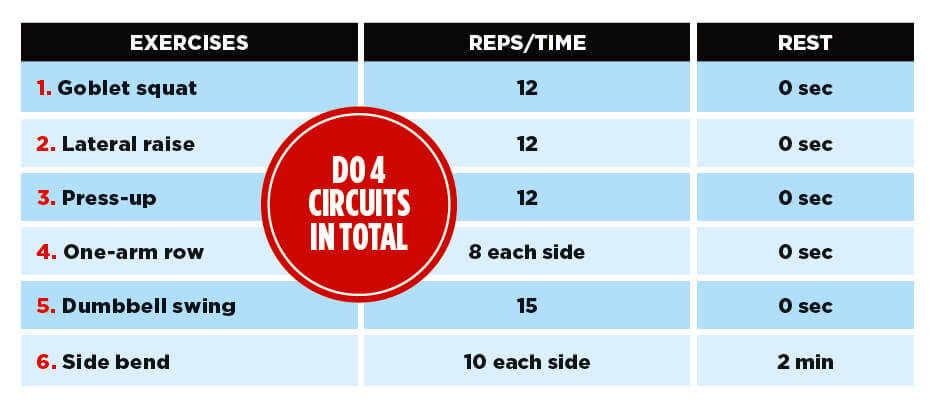
By now you should be familiar with the whole-body nature of these workouts.
The third circuit follows the same general system as the first two, starting with a lower-body exercise and continuing with three upper-body moves that each target a different muscle group. We’re sticking with the dumbbell swing because it is so effective.
It’s a misconception that you need to make every exercise of every session different. Sometimes it makes sense to get good at a move, so you can really attack it and enjoy the benefits, rather than doing it tentatively with poor movement patterns. The circuit finishes with a move that works your obliques (side abs).
1. Dumbbell goblet squat
The goblet squat is a simple and safe variation that reduces the risk of injury and is ideal for beginners. Because the weight is in front of you, it encourages your torso to remain upright to counterbalance the weight.
- Stand tall, with your feet shoulder-width apart and your toes turned out in a ten-to-two position.
- Hold a dumbbell in both hands by your chest and lower into a squat, then push back up to the start position.
2. Dumbbell lateral raise
If done correctly, this is a highly effective way of adding size and width to your shoulders – putting you on the fast track to a great-looking upper body. Make sure you follow the form guide closely to maximise the benefit.
- Stand tall with your chest up and your core braced, holding a dumbbell in each hand.
- Raise the weights out to the sides, leading with your elbows, until they reach shoulder height.
- Lower them slowly to return to the start.
3. Press-up
Press-ups are a classic chest builder, but doing them with a relatively fast tempo makes them more of a cardiovascular challenge, pushing your heart rate up while keeping muscle fatigue to a minimum.
- Start in the press-up position with your hands directly underneath your shoulders, your core and glutes braced, and your feet together.
- Bend your elbows to lower your chest to the ground, then press back up powerfully to return to the start.
4. Dumbbell one-arm row
Doing this single-arm version of the row allows you to completely concentrate on a small and specific target body part, which will help you to fatigue the muscle and ensure balanced development.
- Place one hand on your knee and hold a dumbbell in the other hand, letting it hang straight down.
- Row the weight up to your side, leading with your elbow and squeezing your biceps and upper back muscles at the top.
5. Dumbbell swing
This should be done as an explosive, high-energy exercise. That will help you to develop a powerful hip drive (the key to this move) and also get your heart rate soaring towards the end of the circuit for a greater fat burn.
- Stand holding a dumbbell between your legs.
- Bend forwards, hingeing at the hips, to send the dumbbell between your legs, then push your hips forwards to straighten up and swing the dumbbell up to shoulder height.
6. Dumbbell side bend
Make sure that you perform this move while holding one dumbbell, rather than two. If you do it while holding two, one dumbbell counterbalances the other and reduces the workload.
- Stand tall, holding a dumbbell in one hand.
- Lower the dumbbell to one side, using your side abs to control the movement, then return to the start.
- Complete all your reps on that side, then switch arms.
Circuit 4
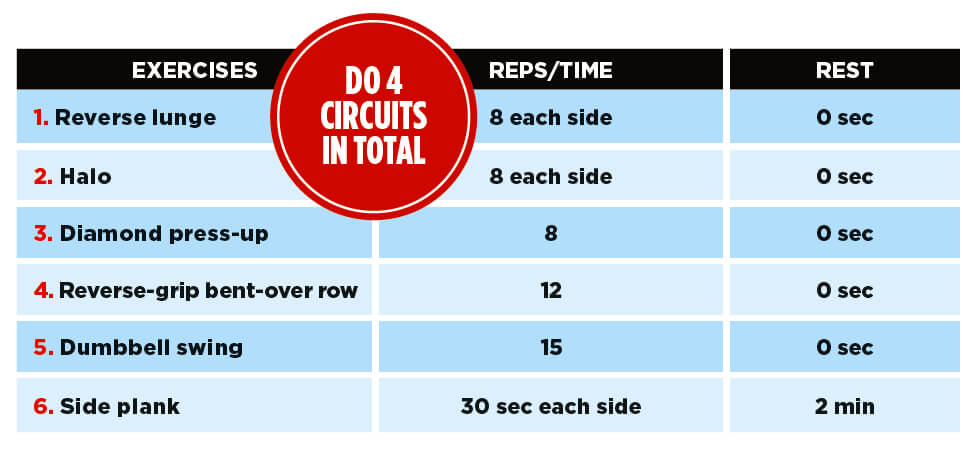
The final circuit of the week involves some twists on familiar moves.
The reverse lunge presents a bigger test to your balance and coordination than the conventional version of the exercise, while also tending to shift the emphasis to your glutes. The diamond press-up is a tough variation of the press-up that places the demand onto your triceps rather than your chest. The reverse-grip bent-over row gives your biceps more of a workout than when you do the move with your palms facing down.
By now, you should be a swing star, able to race through the reps of your fifth move – the dumbbell swing – before finishing with a static hold that will challenge your entire abs and core.
1. Dumbbell reverse lunge
The reverse version of the lunge puts more emphasis on your glute muscles and also makes the exercise harder, giving you a bigger balance and coordination challenge than the standard move.
- Stand tall, holding a dumbbell in each hand.
- Take a big step backwards and bend your knees until they are both bent at 90°.
- Push back up to the start and repeat the move on the other side.
- Alternate sides.
2. Dumbbell halo
This dynamic abs and shoulders move gives you a multi-faceted challenge. You need to work hard to stabilise the dumbbell, which tests your abs because you have to control the acceleration and deceleration of the weight.
- Hold a dumbbell in both hands, then powerfully move it up, across your body, around the back of your head and down across your body.
- Repeat the move going in the opposite direction.
- Alternate sides.
3. Diamond press-up
The hand position in this press-up progression moves the main challenge away from your chest and towards your triceps. It’s a difficult move, but don’t compromise on range of motion in an attempt to complete the reps.
- Start in a press-up position, but with your thumbs and forefingers together to form a diamond shape.
- Lower your chest to the floor, keeping your elbows close to your sides, then press back up.
4. Dumbbell reverse-grip bent-over row
Switching to a reverse grip provides a challenge to your biceps as you draw the weights in to your sides. This is useful because that muscle group isn’t targeted elsewhere in the workout.
- Stand tall with your chest up and your core braced, holding dumbbells with palms facing forwards.
- Bend forwards from your hips, then row the weights up to your sides, leading with your elbows.
- Lower the weights to the start.
5. Dumbbell swing
This should be done as an explosive, high-energy exercise. That will help you to develop a powerful hip drive (the key to this move) and also get your heart rate soaring towards the end of the circuit for a greater fat burn.
- Stand holding a dumbbell between your legs.
- Bend forwards, hingeing at the hips, to send the dumbbell between your legs, then push your hips forwards to straighten up and swing the dumbbell up to shoulder height.
6. Side plank
This is another way to work the muscles – specifically the core, abs and lower back, but also the glutes – statically. Doing the side plank also tests your balance because it is a difficult position to hold.
- Position yourself on your side, supported on your elbow, then raise your hips and keep your body in a straight line from head to heels for the time indicated.
- Switch to the other side and repeat.
Train in the right trainers with our pick of the best gym shoes for 2023
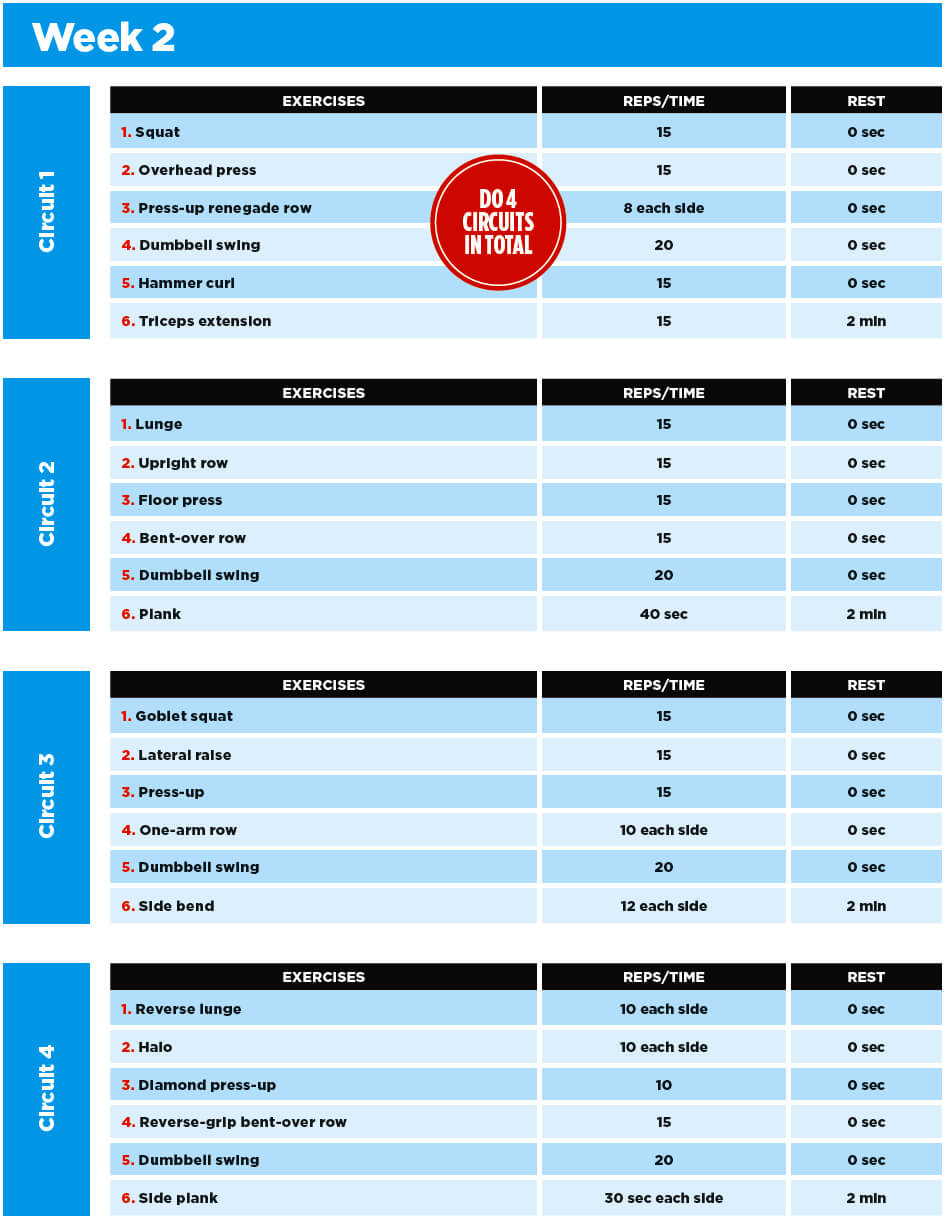
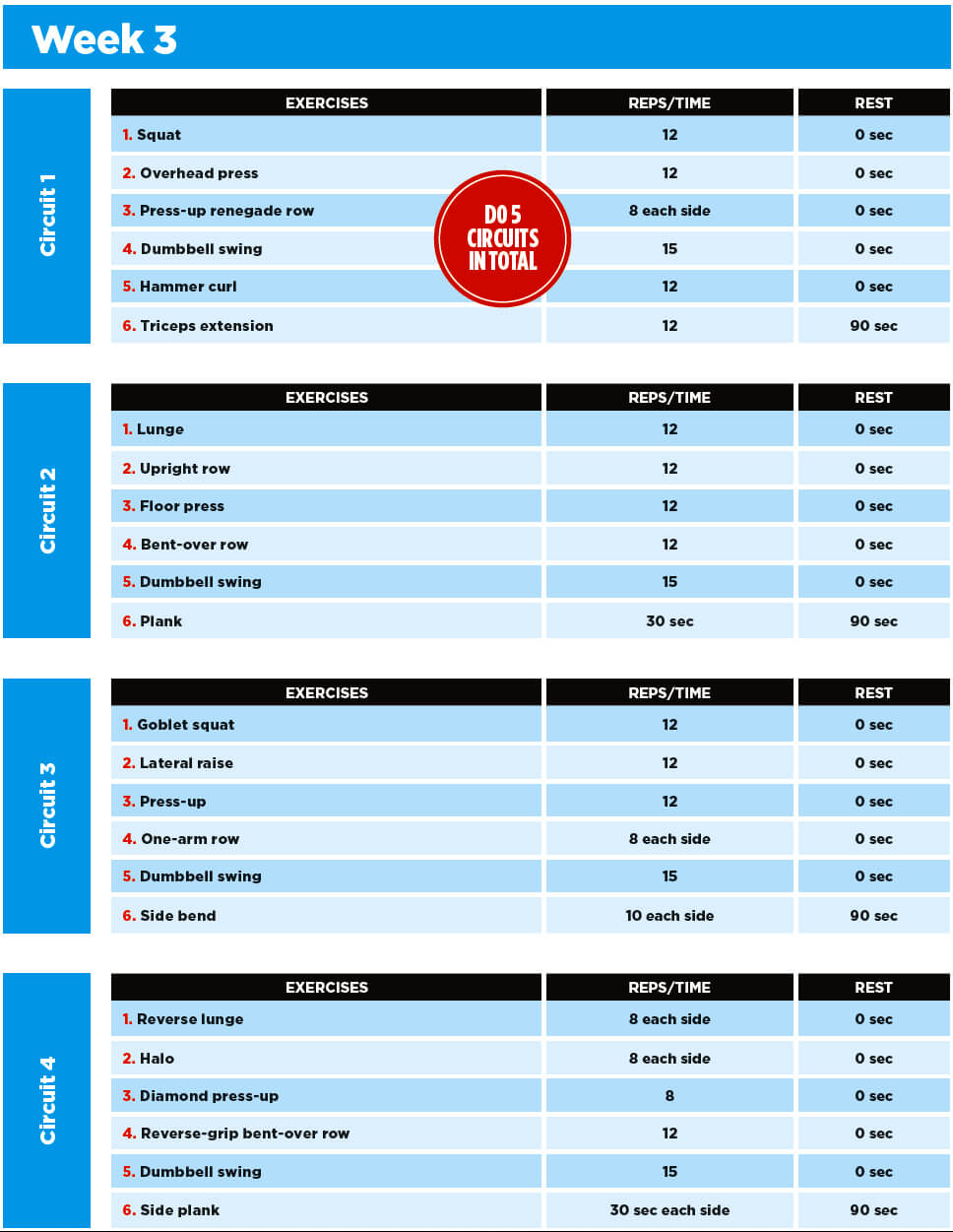
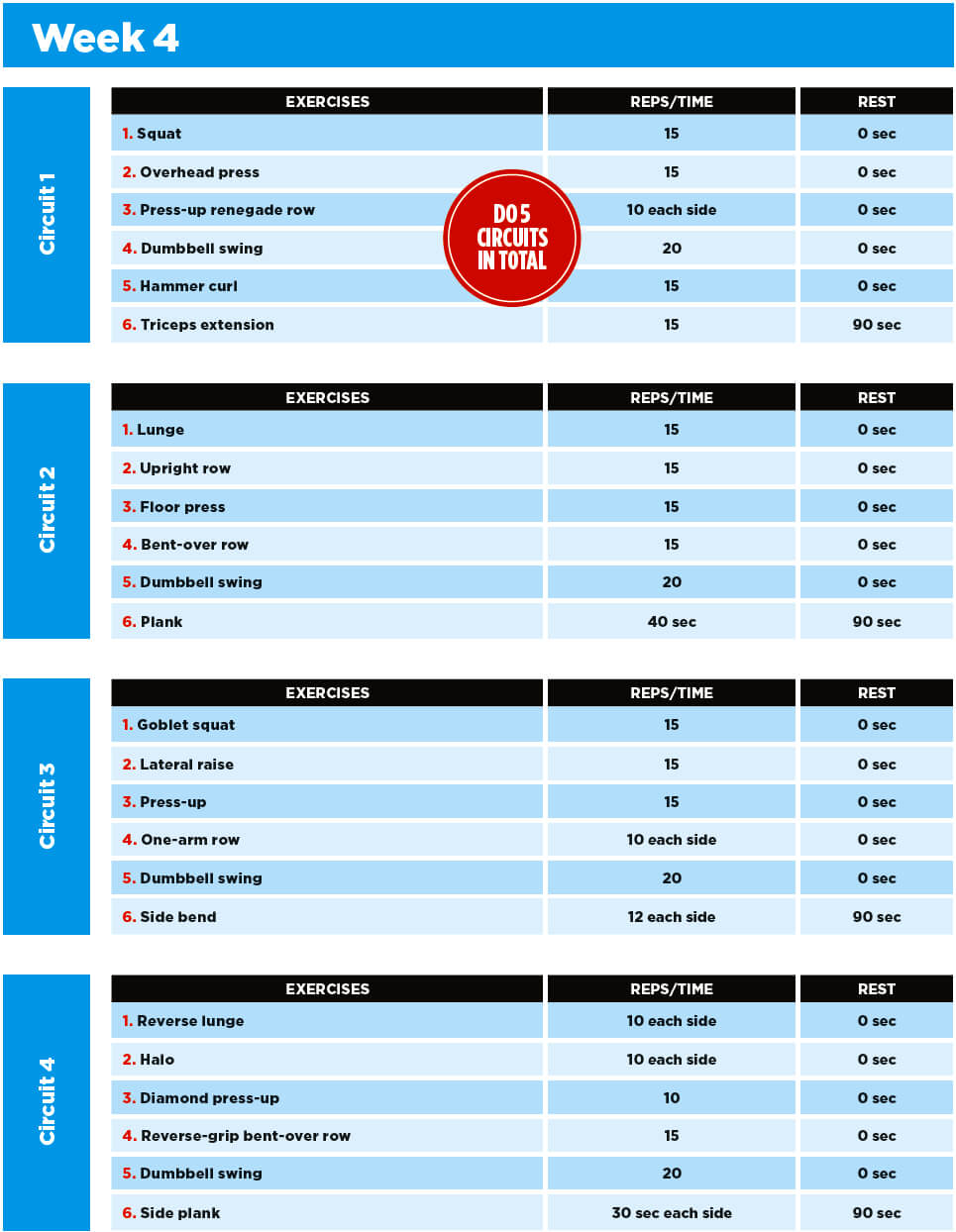
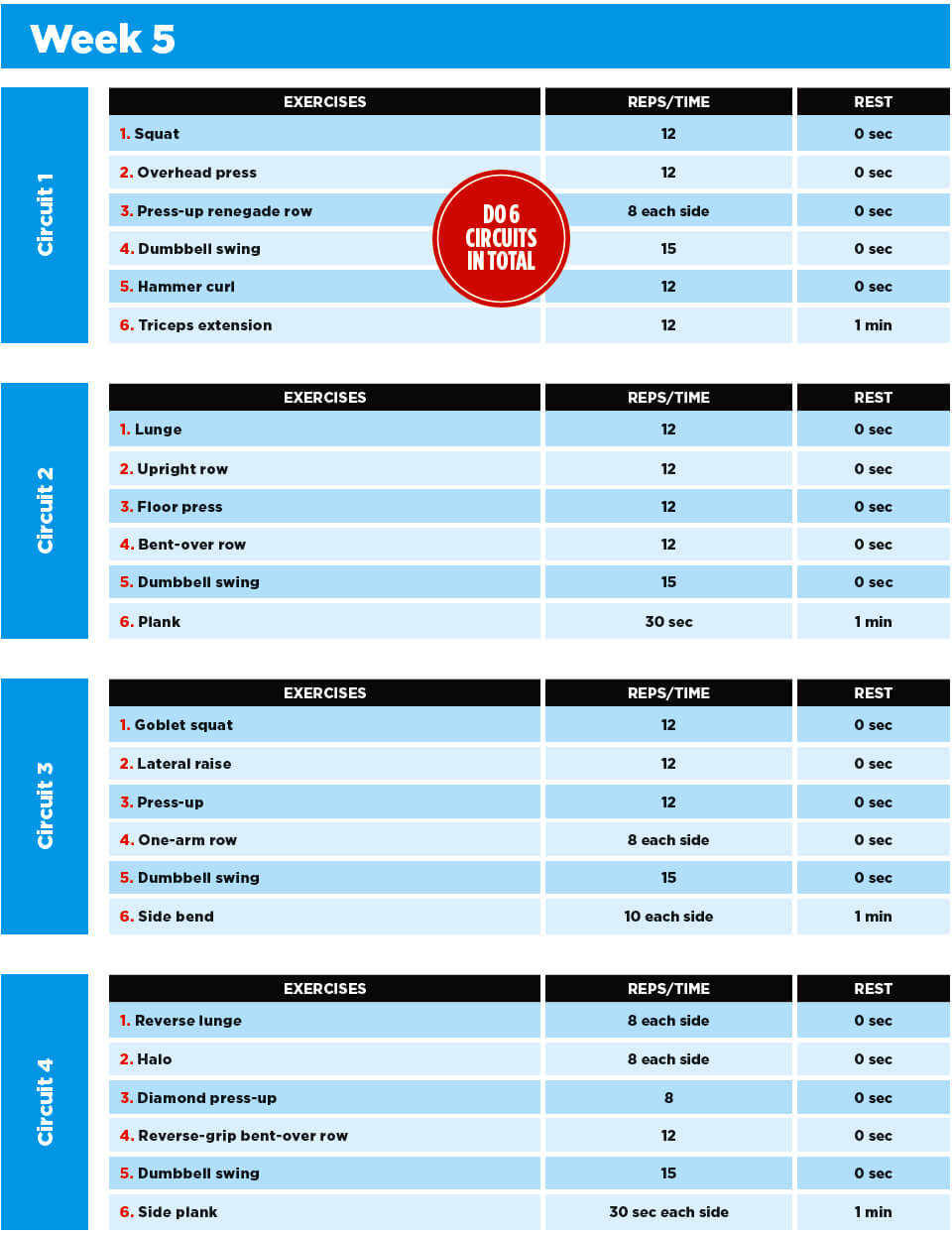
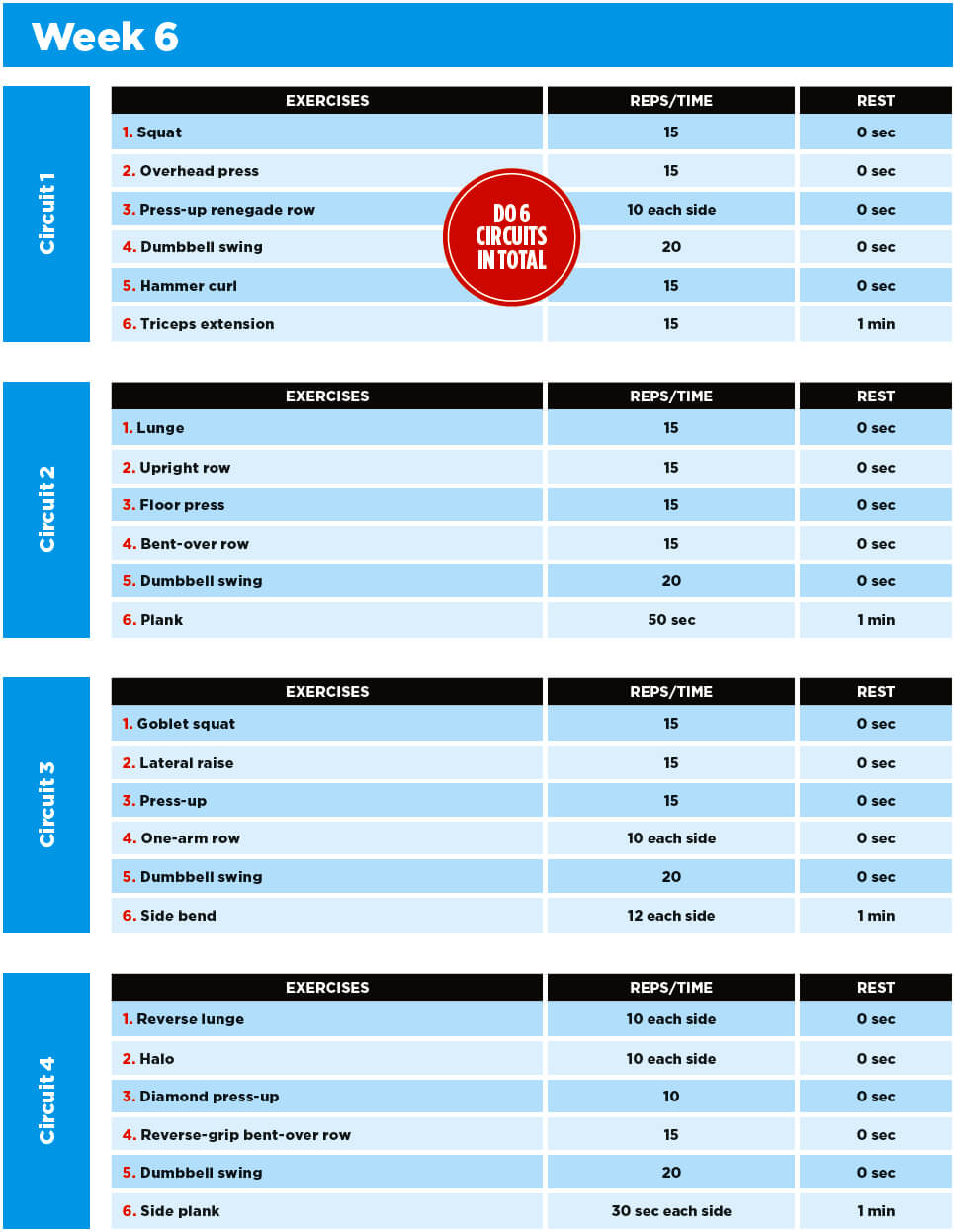
Finished this 6-week fat loss plan and need more inspiration? Scroll through our Workouts Archive for sessions to suit every goal
The post 6-Week Fat Loss Plan appeared first on MensFitness.
[ad_2]Article link

